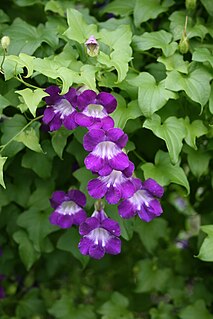
Royal Botanic Gardens, Kew, is a non-departmental public body in the United Kingdom sponsored by the Department for Environment, Food and Rural Affairs. An internationally important botanical research and education institution, it employs 1,100 staff. Its board of trustees is chaired by Dame Amelia Fawcett.

Bulbophyllum is a genus of mostly epiphytic and lithophytic orchids in the family Orchidaceae. It is the largest genus in the orchid family and one of the largest genera of flowering plants with more than 2,000 species, exceeded in number only by Astragalus. These orchids are found in diverse habitats throughout most of the warmer parts of the world including Africa, southern Asia, Latin America, the West Indies, and various islands in the Indian and Pacific Oceans. Orchids in this genus have thread-like or fibrous roots that creep over the surface of trees or rocks or hang from branches. The stem is divided into a rhizome and a pseudobulb, a feature that distinguished this genus from Dendrobium. There is usually only a single leaf at the top of the pseudobulb and from one to many flowers are arranged along an unbranched flowering stem that arises from the base of the pseudobulb. Several attempts have been made to separate Bulbophyllum into smaller genera, but most have not been accepted by the World Checklist of Selected Plant Families.

Retama is a genus of flowering bushes in the legume family, Fabaceae. It belongs to the broom tribe, Genisteae. Retama broom bushes are found natively in North Africa, the Levant and some parts of southern Europe. Retama raetam and Retama monosperma have white flowers, while Retama sphaerocarpa has yellow flowers. It remains an open question in taxonomy whether the members of the genus Retama should be incorporated into the genus Genista.

Hepatica is a genus of herbaceous perennials in the buttercup family, native to central and northern Europe, Asia and eastern North America. Some botanists include Hepatica within a wider interpretation of Anemone.

Kirstenbosch is an important botanical garden nestled at the eastern foot of Table Mountain in Cape Town. The garden is one of ten National Botanical Gardens covering five of South Africa's six different biomes and administered by the South African National Biodiversity Institute (SANBI). Prior to 1 September 2004, the institute was known as the National Botanical Institute.
Spathiostemon is a genus of trees in the Euphorbiaceae family. It is native to the Bismarck Archipelago, New Guinea, Wallacea and Southeast Asia. The trees grow between 10 and 20m tall, often in secondary forest. The wood is sometimes used.

Caspar Georg Carl Reinwardt was a Prussian-born Dutch botanist. He is considered to be the founding father of Bogor Botanical Garden in Indonesia.

Protea laurifolia, also known as the grey-leaf sugarbush, is a shrub from South Africa. It is native to the Cape Provinces of South Africa.

Ehretia is a genus of flowering plants in the borage family, Boraginaceae. It contains about 50 species. The generic name honors German botanical illustrator Georg Dionysius Ehret (1708–1770).
Polevansia is a genus of African plants in the grass family. The only known species is Polevansia rigida. native to Lesotho and to Cape Province.
Bernard Hyland, known as Bernie Hyland, has a long career as an Australian botanist.

Maurandya is a genus of flowering plants in the family Plantaginaceae, native to Mexico and the south west United States. They sprawl or climb by means of twining leaf stalks. One of the four species, Maurandya barclayana, is widely cultivated as an ornamental plant.
Bernard de Winter was a South African botanist who from 1973 was Director of the Botanical Research Institute, which later became the National Botanical Institute and then the South African National Biodiversity Institute.

Holmgrenanthe petrophila is a rare perennial desert plant in the plantain family (Plantaginaceae), and the sole species of the genus Holmgrenanthe. It forms low mats of branched stems growing from a woody base. The leaves have small spines along their edges. The solitary yellow flowers are tubular with five free lobes at the end, the upper two pointing backwards, the lower three projecting forwards. The species is known only from about ten locations, most in the Titus Canyon and the adjacent Fall Canyon, all within the Californian section of Death Valley National Park. It grows in limestone crevices on the canyon walls, often on the north face.

Aleksandr Vasiljevich Fomin was a Russian botanist that lived during the reign of the Soviet Union. He studied ferns and seed plants. He was also a director of the Kiev University Botanical Garden; which was renamed after him, when he died.
George Hill Mathewson Lawrence, was a United States botanist, author and Professor of Botany. He helped establish the 'Liberty Hyde Bailey Hortorium', the Hunt Botanical Library and the Huntia journal. He was also an avid book collector,.

Protea pudens, also known as the bashful sugarbush, is a low-growing, groundcover-like, flowering shrub in the genus Protea. It is only found growing in the wild in a small area in the Western Cape province of South Africa.

Protea punctata, also known as the water sugarbush or water white sugarbush, is a shrub belonging to the genus Protea which is found growing in the wild in South Africa.

Anne M. Schot is a Nederlander botanist.













